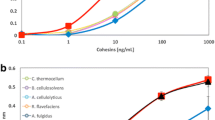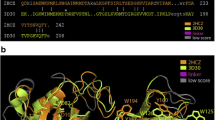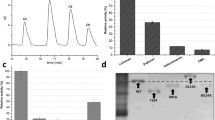Abstract
Fruit softening is associated to cell wall modifications produced by a set of hydrolytic enzymes and proteins. Expansins are proteins with no catalytic activity, which have been associated with several processes during plant growth and development. A role for expansins has been proposed during softening of fruits, and many fruit-specific expansins have been identified in a variety of species. A 3D model for VpEXPA2, an α-expansin involved in softening of Vasconcellea pubescens fruit, was built for the first time by comparative modeling strategy. The model was validated and refined by molecular dynamics simulation. The VpEXPA2 model shows a cellulose binding domain with a β-sandwich structure, and a catalytic domain with a similar structure to the catalytic core of endoglucanase V (EGV) from Humicola insolens, formed by six β-strands with interconnected loops. VpEXPA2 protein contains essential structural moieties related to the catalytic mechanism of EGV, such as the conserved HFD motif. Nevertheless, changes in the catalytic environment are observed in the protein model, influencing its mode of action. The lack of catalytic activity of this expansin and its preference for cellulose are discussed in light of the structural information obtained from the VpEXPA2 protein model, regarding the distance between critical amino acid residues. Finally, the VpEXPA2 model improves our understanding on the mechanism of action of α-expansins on plant cell walls during softening of V. pubescens fruit.

Homology model, molecular docking and MD simulations exploring the α-expansin interaction from mountain papaya fruit (VpEXPA2) with two putative ligands. Homology model of VpEXPA2 in surface and cartoon representations, showing the two-domain structure (left). A cellulosic ligand (cellodextrin 8-mer; center) and a hemicellulosic ligand (right) shows different conformation into the open groove of VpEXPA2, and are in agreement with the binding energy differences.








Similar content being viewed by others
References
McQueen-Mason S, Durachko DM, Cosgrove DJ (1992) Two endogenous proteins that induce cell wall expansion in plants. Plant Cell 4:1425–1433
McQueen-Mason S, Cosgrove DJ (1994) Disruption of hydrogen bonding between plant cell wall polymers by proteins that induce wall extension. Proc Natl Acad Sci U S A 91:6574–6578
Kende H, Bradford K, Brummell D, Cho HT, Cosgrove DJ, Fleming A, Gehring C, Lee Y, McQueen-Mason S, Rose JK, Voesenek LA (2004) Nomenclature for members of the expansin superfamily of genes and proteins. Plant Mol Biol 55:311–314
Sampedro J, Cosgrove DJ (2005) The expansin superfamily. Genome Biol 6:242
Davies GJ, Tolley SP, Henrissat B, Hjort C, Schülein M (1995) Structures of oligosaccharide-bound forms of the endoglucanase V from Humicola insolens at 1.9 Å resolution. Biochemistry 34:16210–16220
Fedorov AA, Ball T, Valenta R, Almo SC (1997) X-ray crystal structures of birch pollen profilin and Phl p 2. Int Arch Allergy Immunol 113:109–113
Cosgrove DJ (2000) Loosening of plant cell walls by expansins. Nature 407:321–326
Yennawar NH, Li L-C, Dudzinski DM, Tabuchi A, Cosgrove DJ (2006) Crystal structure and activities of EXPB1 (Zea m1), a β-expansin and group-1 pollen allergen from maize. Proc Natl Acad Sci U S A 103:14664–14671
Georgelis N, Tabuchi A, Nikolaidis N, Cosgrove DJ (2011) Structure-Function analysis of the bacterial expansin EXLX1. J Biol Chem 286:16814–16823
Whitney SEC, Gidley MJ, McQueen-Mason S (2000) Probing expansin action using cellulose/hemicellulose composites. Plant J 22:327–334
Gaete-Eastman C, Figueroa CR, Balbontín C, Moya M, Atkinson RG, Herrera R, Moya-León MA (2009) Expression of an ethylene-related expansin gene during softening of mountain papaya fruit. Postharvest Biol Technol 53:58–65
Georgelis N, Yennawar NH, Cosgrove DJ (2012) Structural basis for entropy-driven cellulose binding by a type-A cellulose-binding module (CBM) and bacterial expansin. Proc Natl Acad Sci U S A 109:14830–14835
Hanus J, Mazeau K (2006) The xyloglucan-cellulose assembly at the atomic scale. Biopolymers 81:59–73
Altschul SF, Gish W, Miller W, Myers EW, Lipman DF (1990) Basic local alignment search tools. J Mol Biol 215:403–410
Jonnes DT (1999) Protein secondary structure prediction based on position specific scoring matrices. J Mol Biol 292:195–202
Thompson J, Higgins D, Gibson T (1994) CLUSTALW: improving the sensitivity of progressive multiple sequence alignment through sequence weighting, position-specific gap penalties and weight matrix choice. Nucleic Acids Res 22:4673–4680
Šali A, Blundell TL (1993) Comparative protein modeling by satisfaction of spatial restraints. J Mol Biol 234:779–815
Brooks BR, Bruccoleri RE, Olafson BD, States DJ, Swaminathan S, Karplus M (1983) CHARMM: a program for macromolecular energy minimization and dynamics calculation. J Comput Chem 4:187–217
Phillips JC, Braun R, Wang W, Gumbart J, Tajkhorshid E, Villa E, Chipot C, Skeel RD, Kale L, Schulten K (2005) Scalable molecular dynamics with NAMD. J Comput Chem 26:1781–1802
MacKerell AD Jr, Bashford D, Bellott M, Dunbrack RL Jr, Evanseck J, Field M, Fischer JS, Gao J, Guo H, Ha S, Joseph D, Kuchnir L, Kuczera K, Lau FTK, Mattos C, Michnick S, Ngo T, Nguyen DT, Prodhom B, Roux B, Schlenkrich M, Smith J, Stote R, Straub J, Watanabe M, Wiorkiewicz-Kuczera J, Yin D, Karplus M (1992) Self-consistent parameterization of biomolecules for molecular modeling and condensed phase simulations. FASEB J 6:A143
Schlenkrich M, Brickmann J, MacKerell AD Jr, Karplus M (1996) In: Roux B, Merz KM (eds) A molecular perspective from computation and experiment. Birkhauser, Boston, pp 31–81
Jorgensen WL, Chandresekhar J, Madura JD, Impey RW, Klein ML (1983) Comparison of simple potential functions for simulating liquid water. J Chem Phys 79:926–935
Sippl MJ (1993) Recognition of errors in three-dimensional structures of proteins. Proteins 17:355–362
Laskowski RA, MacArthur MW, Moss DS, Thornton JM (1993) PROCHECK: a program to check the stereochemical quality of protein structures. J Appl Cryst 26:283–291
Lüthy R, Bowie JU, Eiserberg D (1992) Assessment of protein models with three- dimensional profiles. Nature 356:83–85
Trott O, Olson AJ (2010) AutoDockVina: improving the speed and accuracy of docking with a new scoring function, efficient optimization and multithreading. J Comput Chem 31:455–461
Vanommeslaeghe K, Hatcher E, Acharya C, Kundu S, Zhong S, Shim J, Darian E, Guvench O, Lopes P, Vorobyov I, MacKerell AD Jr (2010) CHARMM general force field: a force field for drug-like molecules compatible with the CHARMM all-atom additive biological force field. J Comput Chem 31:671–690
Essmann U, Perera L, Berkowitz ML, Darden T, Lee H, Pedersen LG (1995) A smooth particle mesh Ewald method. J Chem Phys 103:8577–8593
Humphrey W, Dalke A, Schulten K (1996) VMD - visual molecular dynamics. J Mol Graph 14:33–38
Li Y, Darley CP, Ongaro V, Fleming A, Schipper O, Baldauf SL, McQueen-Mason SJ (2002) Plant expansins are a complex multigene family with an ancient evolutionary origin. Plant Physiol 128:854–864
Cosgrove DJ, Li LC, Cho H-T, Hoffmann-Benning S, Moore RC, Blecker D (2002) The growing world of expansins. Plant Cell Physiol 43:1436–1444
Cosgrove DJ, Bendinger P, Durachko D (1997) Group I allergen of grass pollen as cell wall-loosening agents. Proc Natl Acad Sci U S A 94:6559–6564
Gilbert HJ, Knox JP, Boraston AB (2013) Advances in understanding the molecular basis of plant cell wall polysaccharide recognition by carbohydrate-binding modules. Curr Opin Struct Biol 23:669–677
Jervis EJ, Haynes CA, Kilburn DG (1997) Surface diffusion of cellulases and their isolated binding domains on cellulose. J Biol Chem 272:24016–24023
Nardi C, Escudero C, Villarreal N, Martínez G, Civello PM (2013) The carbohydrate-binding module of Fragaria x ananassa expansin 2 (CBM-FaEXP2) binds to cell wall polysaccharides and decreases cell wall enzymes activities ‘in vitro’. J Plant Res 126:151–159
Acknowledgments
L. Morales-Quintana acknowledges CONICYT for a doctoral fellowship. This work has been supported by Initiation FONDECYT grant N° 11100481 and CONICYT Anillo ACT-1110 project.
Author information
Authors and Affiliations
Corresponding authors
Rights and permissions
About this article
Cite this article
Gaete-Eastman, C., Morales-Quintana, L., Herrera, R. et al. In-silico analysis of the structure and binding site features of an α-expansin protein from mountain papaya fruit (VpEXPA2), through molecular modeling, docking, and dynamics simulation studies. J Mol Model 21, 115 (2015). https://doi.org/10.1007/s00894-015-2656-7
Received:
Accepted:
Published:
DOI: https://doi.org/10.1007/s00894-015-2656-7




